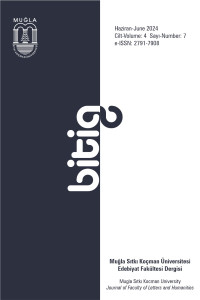Research Articles
Book Reviews
Issue Reviewers

Turkish Savannah Culture, General Turkish History, Pre-Islamic Turkish History
Asst. Prof. Dr.
Ali BELENLİ
KÜTAHYA DUMLUPINAR ÜNİVERSİTESİ
Literary Theory, Medieval Literature, British and Irish Language, Literature and Culture
Cultural and Natural Heritage
Art History
Assoc. Prof. Dr.
Cengiz GÜRBIYIK
MANİSA CELÂL BAYAR ÜNİVERSİTESİ
Urban in Art History , History of Architecture
Asst. Prof. Dr.
Ebru AÇIK TURGUTER
Muğla Sıtkı Koçman Üniversitesi,SOSYOLOJİ BÖLÜMÜ
Sociology, Literature Sociology

Language Studies, British and Irish Language, Literature and Culture
Assoc. Prof. Dr.
Figen ÇEVİRİCİ COŞKUN
Kütahya Dumlupınar Üniversitesi
Greek and Roman Period Archeology, Archaeology, Archaic Period Archeology, Hellenistic Period Archeology, Classical Period Archeology
Assoc. Prof. Dr.
Füsun KÖKALAN ÇIMRIN
DOKUZ EYLÜL ÜNİVERSİTESİ
Qualitative Methods in Sociology, Sociology
Assoc. Prof. Dr.
Gaye GÖKALP YILMAZ
MEHMET AKİF ERSOY ÜNİVERSİTESİ, FEN-EDEBİYAT FAKÜLTESİ, SOSYOLOJİ BÖLÜMÜ
 0000-0002-6304-3425
0000-0002-6304-3425
 0000-0002-6304-3425
0000-0002-6304-3425
Social Change, Sociology

Contemporary Art, Art History, Ceramic Design
Prof. Dr.
Gül AKTAŞ
Pamukkale Üniversitesi
Family Sociology , Youth Sociology , Women's Studies, Sociology of Family and Relationships

Assoc. Prof. Dr.
Hasan UÇAR
EGE ÜNİVERSİTESİ, EDEBİYAT FAKÜLTESİ, SANAT TARİHİ BÖLÜMÜ, SANAT TARİHİ ANABİLİM DALI
Turkish-Islamic Arts History

Prof. Dr.
Hasan ŞEN
Muğla Sıtkı Koçman Üniversitesi
Sociology
Classical Turkish Literature, Language Studies, Classical Turkish Literature of Ottoman Field

Language Studies, Turkish Language and Literature (Other), Turkish Folklore, Social and Cultural Anthropology, Ethnology, Alawism Bektashism Studies
Dr. Instructor
Nilüfer KARADAVUT
ADNAN MENDERES ÜNİVERSİTESİ, REKTÖRLÜK
Classical Turkish Literature, Classical Turkish Literature of Ottoman Field

British and Irish Language, Literature and Culture
Archaeology, Archaic Period Archeology, Habitat Archeology
Prof. Dr.
Satı KUMARTAŞLIOĞLU
Balıkesir Üniversitesi
Turkish Folklore

Assoc. Prof. Dr.
Sergender SEZER
MUĞLA SITKI KOÇMAN ÜNİVERSİTESİ, EDEBİYAT FAKÜLTESİ
 0000-0002-7097-8691
0000-0002-7097-8691
 0000-0002-7097-8691
0000-0002-7097-8691
Quantitative Methods in Sociology, Social Change, Game Sociology, Rural Sociology, Urban Sociology and Community Studies, Women's Studies, Labor and Organisition Sociology, Sociology of Law, Migration Sociology, Youth Sociology , Change, Underdevelopment and Modernisation Sociology, Sociology of Gender, Environmental Sociology, Body Sociology, Sociology of Family and Relationships, Forensic Social Science, Sociology, Crime and Punishment , Psychology of Ageing, Qualitative Methods in Sociology
Turkish Folklore in the Türkiye Field

Dr.
Süleyman YİĞİT
Muğla Sıtkı Koçman Üniversitesi, Sosyal Bilimler Enstitüsü, Türk Dili ve Edebiyatı Anabilim Dalı
Classical Turkish Literature of Ottoman Field, Language Studies, Turkish Islamic Literature
British and Irish Language, Literature and Culture
Assoc. Prof. Dr.
Zeynep ÖZDEM KÖSE
MUĞLA SITKI KOÇMAN ÜNİVERSİTESİ
Ottoman Society
Prof. Dr.
Özlem IRMAK BALKIZ
ADNAN MENDERES ÜNİVERSİTESİ, FEN-EDEBİYAT FAKÜLTESİ, SOSYOLOJİ BÖLÜMÜ
Labor Sociology, Industrial Sociology, Management Sociology, Sociology
Aim & Scope
bitig Journal of Faculty of Letters aims to contribute to the knowledge of social sciences by publishing national and international original scientific research articles and book reviews in the field of language, literature, social and human sciences since June, 2021. bitig Journal of Faculty of Letters, which is an international peer-reviewed journal, publishes two issues in a year (June and December). With its open-access policy, the journal provides researchers with comfortable and unlimited access.
bitig Journal of Faculty of Letters, which is the publication organ of Muğla Sıtkı Koçman University Faculty of Letters, covers basic studies in the fields of Archeology, Art History, English Translation and Interpreting, English Language and Literature, History, Modern Turkish Dialects and Literatures, Philosophy, Psychology, Sociology, Turkish Language and Literature. In these fields and related sub-fields, both conceptual and field research-based studies are included for the dissemination and development of knowledge, especially considering interdisciplinarity. Turkish and English articles are accepted in our journal.
Author Guidelines
Scientific studies sent to bitig Journal of Faculty of Letters by Muğla Sıtkı Koçman University must not have been previously published or sent for publication. The publication decision regarding the studies submitted to the journal, and the identity of the authors and referees are kept confidential. Scientific and original research articles, translations and book reviews in the aforementioned fields can be sent to the journal. More than one work by the same author/authors cannot be published in the same issue of the journal.
The journal accepts articles in Turkish and English.
Spelling and punctuation are based on the latest edition of the Spelling Dictionary by Turkish Language Institution (TDK). The papers submitted should be clear and comprehensible and in accordance with scientific criteria in terms of language and expression. If necessary, papers can be corrected in terms of spelling rules by the editors.
Authors are responsible for the compliance of the papers with the ethical rules. The similarity rate to other scientific publications should not exceed 25%. Besides, the editor reserves the right to request an ethics committee document from the authors if necessary.
Research articles sent to the journal must be at least 8000, maximum 10.000 words; book reviews should be a minimum of 3000 and a maximum of 5000 words. Translations, text publications and works containing excavation reports in the field of Archaeology are excluded from this rule.
Submissions from the basic fields of social sciences and philology are accepted to the journal. Papers should be prepared on the following template:
Title: The title should be short and informative about the research topic. Only the first letter of the words should be capitalized (excluding the conjunctions). They should be in 14 font size, bold and centred. The English title should be written under the Turkish title and should be 12 points.
Author Information: The first letter of the author's name and all letters of the surname should be written in capital letters, 11 font size, bold and centred. The institution where the authors work, their e-mail addresses and ORCID numbers should be given in the footnote with a “*” sign.
Abstract: At the beginning of each article, there must be an abstract in Turkish and English, consisting of at least 250 and maximum 500 words, reflecting the purpose, method and findings of the research. Each article should contain at least five and at most eight keywords related to the abstract. Abstract and keywords should be written in 10 points. The abstract title should be 10 points, the abstract should be single line spacing, 9 points and the left and right should be indented 1 cm.
Paper Size: A4 Vertical
Top Margin: 2.5 cm
Bottom Margin: 2.5 cm
Left Margin: 2.5 cm
Right Margin: 2.5 cm
Font: Montserrat
Font Style: Normal
Size (Normal Text): 10
Size (Footnote Text): 9
Table-Graphic: 9
Paragraph Spacing: Single Line (0 pt before, 0 pt After) (0 pt before and after in tables and graphs) No paragraph indents
Line spacing: Text single line (0 pt before, 8 pt after); abstract and footnote single line spacing. Abstract should have 1 cm indent on the right and left.
References: 0 cm per paragraph in the lines of the references (lines should be indented 1.25 cm)
For articles that use a special font, the font used should also be sent to the journal with the text.
The parts that need to be emphasized in the text should not be in bold letters but italicized or in quotation marks.
Details such as page numbers, headers and footers should not be included in the articles.
Chapter titles: All main and sub-headings should be written with only the first letters capitalized and bold, left aligned, and all section headings should be in 10 points.
Tables, Graphics and Images: Tables, graphics and visuals should have numbers and titles, and these numbers and names should be just below the figure. Images to be used in articles should be in jpeg or tiff format and their resolution should not be less than 300 dpi.
Abbreviations: In submissions, the abbreviations used in the articles, the official abbreviation index and rules of the language in which the article is written should be followed. For Turkish, the TDK Abbreviations Index should be taken as a basis.
Quotations: Direct quotes should be quoted. Quotations of less than 4 lines should be quoted in the paragraph, and quotes of 5 or more lines should be given in the form of independent paragraphs. Such blocks should have a space of 1 cm from the left and right of the citation, should not be given a paragraph head and should be 9 pt in size. The line spacing must also be 1 cm.
Submission: Parenthetical references should be used for in-text citations of the article. There must be a bibliography at the end of the article.
It should be stated in the format in single-authored publications like (Akar 2020: 56), and in multi-authored citations like (Ayan et al. 2013: 35).
If the name of the cited author is included in the text, only the publication year and page should be indicated: (2004: 37).
Electronic sources should be specified as (URL-1), (URL-2), … in the text and should be written as follows in the “References” section:
URL-1: Mesîhî (2020), Mesîhî Dîvânı, haz. Mine Mengi, https://ekitap.ktb.gov.tr/Eklenti/10686,metinpdf.pdf?0 (e.t. 23.12.2020).
The names of the ancient works and authors should be given without any abbreviations.
Sample: Ksenophon, Oikonomikos, 2.21.
If there are more than three references to a concept or citation in the articles which sent to the journal, footnotes can be used.
References: References should be given in alphabetical order at the end of the main text according to the surnames of the authors.
Sample: Tanpınar, Ahmet Hamdi (1988), Huzur, İstanbul: Dergâh Yay.
If the article has two authors, the surname of the author who is first in the work is given first.
Sample: Parlatır, İsmail ve Nurullah Çetin (1996), Genç Kalemler Dergisi, Ankara: Akçağ Yayınları.
If the article has more than three authors, after the information of the first author, the abbreviation of et al. should be used.
Sample: Kaplan, Mehmet et al. (1983), Devrin Yazarlarının Kalemiyle Millî Mücadele, Ankara: Kültür ve Turizm Bakanlığı Yayınları.
The names of major-independent works such as book and journal titles should be written in italics, and minor-dependent works such as book chapters and poems should be written normally but in quotation marks.
If the chapters of a journal, encyclopedia article, or book are used, page range information should be given at the end of the references. The display of journal and encyclopedia articles (volume, issue and page) should be as follows:
Sample: Ayhan, Gökben (2022), "Geleneksel Ula Evlerinde Çıkma", bitig Edebiyat Fakültesi Dergisi, 2 (4), 282-297.
If there is a translator, compiler or preparer, the name of the editor should be given after the name of the author and the work.
Sample: Rosenau, P. Marie (1992), Postmodernizm ve Toplum Bilimleri, çev. Tuncay Birkan, İstanbul: Ark Yay.
In case there is more than one work of the same author with the same date in the references, it should be shown as "a, b, c ...".
Sample: (İpekten 2001a: 82)
If the thesis is used, the surname-name of the author, the date of the thesis, the title of the thesis in italic characters, the type of the thesis, the name of the city and the university should be included.
Sample: Dündar, Leyla Burcu (2001), Murathan Mungan’ın Çağdaş Masallarında Cinsiyetçi Geleneğin Eleştirisi, Ankara: Bilkent Üniversitesi Ekonomi ve Sosyal Bilimler Enstitüsü Türk Edebiyatı Disiplini Yüksek Lisans Tezi.
Ethical Principles and Publication Policy
bitig Journal of Faculty of Letters by Muğla Sıtkı Koçman University adheres to the ethical principles and publication policies with the editorial and advisory board members, referees, and authors involved in the publication process. Papers submitted to the journal for publication should comply with the rules of “Scientific Research and Publication Ethics Directive of Higher Education Institutions.” Statements listed under “Actions Against the Scientific Research and Publication Ethics” are to be avoided. For the articles sent to the journal, international standards published by COPE (Committee on Publication Ethics) https://publicationethics.org/ for Editors and Authors will be taken into consideration. In light of this information, the following ethical standards are presented:
Ethical Responsibilities of the Editorial Board
(1) The Editorial Board is responsible for each article submission to bitig Journal of Faculty of Letters, and that applies for the whole process – from the receipt of the paper until its publication.
(2) The Editorial Board preserves the intellectual property rights of published articles.
(3) The Editorial Board examines the article submissions in matters of plagiarism, scientific originality, and ethics.
(4) The Editorial Board sends the papers to language and style coordinators of the journal by hiding the personal details of the authors. The compliance of the journal with the spelling rules is examined here. If necessary, the articles are requested to be corrected and uploaded to the system again.
(5) Papers approved by the Editorial Board are sent to two referees. Those who receive a positive report from both referees are published. If a positive report and a negative report are received, the paper is sent to a third referee. Thus, the decision is determined according to the report of the third referee.
(6) The Editorial Board keeps the identity information of the referees confidential and ensures that each article is evaluated impartially and within the specified time.
(7) The Editorial Board takes into account the consistent criticisms of the articles published in the journal and gives the right to reply to the authors of the articles that are criticized.
(8) The Editorial Board continuously strives to improve the quality of the journal through its publications.
(9) The Editorial Board maintains effective communication with those involved in the publication process and therefore meets periodically in line with the development goals of the journal.
(10) The Editorial Board is responsible for archiving each work.
Ethical Responsibilities of the Advisory Board
(1) The academics appointed as advisors to bitig Journal of Faculty of Letters are chosen based on their fields of expertise.
(2) Members of the Advisory Board conduct their evaluations in accordance with the principle of impartiality.
(3) The Advisory Board is responsible for advising the journal with suggestions to expand the referee pool, find suitable referees, promote the journal in national and international platforms, and increase the quality of other scientific and technical issues.
Ethical Responsibilities of the Referees
(1) All referees accepting an invitation to referee are expected to comply with international referee standards. Accordingly, they must adopt the principles of the COPE -Committee on Publication Ethics-.
(2) The principle of blind refereeing is applied in bitig Journal of Faculty of Letters. Referees do not directly communicate with authors.
(3) Referees only evaluate the articles related to their field of expertise.
(4) The referees conduct the evaluation within the principles of impartiality and confidentiality.
(5) The referees are obliged to evaluate the articles they accept within the time given to them.
(6) The referees make their evaluations in a constructive manner; they avoid harsh criticism and personal comments.
Ethical Responsibilities of the Authors
(1) Authors who submit their studies to the journal should provide their full academic titles, name and surname, and the institution they work for. They should add the full address, telephone number and e-mail address, as well.
(2) Authors are obliged to submit their original (unpublished) works to bitig Journal of Faculty of Letters and to follow the writing instructions given on the journal website. Authors should not submit works that have been previously published or whose peer-review process has begun on another platform. If the authors apply to our journal with a publication they have prepared or presented from their scientific activities and studies, they must declare the relevant information. In case of a contrary situation, the author will be responsible for the situation in accordance with the relevant sanctions.
(3) Authors have the responsibility that the papers submitted to the journal are original and that they are written in accordance with scientific ethical principles. The author's plagiarism report is examined through various programs such as iThenticate, Turnitin or intihal.net. Authors are obliged to upload the reports. If the result of the report is above 25%, the article will not be evaluated.
(4) The authors acknowledge that they have transferred the copyrights of the published articles to bitig Journal of Faculty of Letters. This transfer becomes obligatory with the acceptance of the article for publication. No part of the printed material can be used elsewhere without the written permission of the publisher. Authors who will send a work to bitig Journal of Faculty of Letters should fill out the "Copyright Transfer Form". Authors must sign the completed form originally and upload it to the system. Click here for the Copyright Transfer Form.
(5) The rights of the authors such as the right to use on personal websites provided that the work record is stated or to keep it in the open archive of the university, the right to use all or part of the work in his own books and other academic works, provided that the source is cited, the right to reproduce the work for its own purposes provided that it is not sold, all unregistered rights except for patent, copyright are preserved.
(6) As for the use of materials such as pictures, figures and etc. in the article, it is the author's responsibility to obtain permission from the necessary persons or institutions for the material to support the narrative.
(7) The decision of ULAKBİM dated February 25, 2020 claims “Ethics Committee Approval must be obtained separately for all branches of science, clinical and experimental studies on humans and animals that require an ethics committee decision, this approval must be stated and documented in the article.” The following situations require ethics committee approval:
• All kinds of research conducted with qualitative or quantitative approaches that require data collection from the participants by using surveys, interview, focus group work, observation, experiment, interview techniques,
• The use of humans and animals (including material/data) for experimental or other scientific purposes,
• Clinical studies on humans,
• Research on animals.
(8) Authors are obliged to report their conflict of interest to bitig Journal of Faculty of Letters.
Price Policy
bitig Edebiyat Fakültesi Dergisi'ne makale gönderim/süreç işletimi ücretsizdir.
bitig Journal of Faculty of Letters is licensed under a  Creative Commons Attribution-NonCommercial-ShareAlike 4.0 International License.
Creative Commons Attribution-NonCommercial-ShareAlike 4.0 International License.

